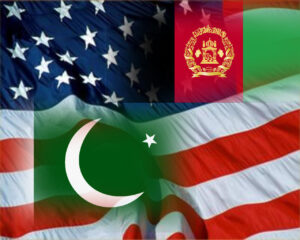

CDA Institute Research Associate Adnan Qaiser with a distinguished career in the armed forces and international diplomacy investigates factors hampering peace and stability in Afghanistan corresponding to the current US policy review.
While the history of Afghanistan is written in blood; it is also inked in flawed outlook and failed policies. Apart from Afghans’ internal paradoxes (discussed in my last article), a landlocked Afghanistan’s near-hostile relations with Pakistan – upon which the country is politically, economically and socially dependent – and United States muddled approach remain obstacles to peace. For the umpteenth time US policy review affirms the failure of strategies in the past fifteen years: changing goals from counterterrorism to nation-building and from counterinsurgency to training and support.
Despite former president, Hamid Karzai, describing the two countries as “conjoined twins,” Pak-Afghan historic mistrust and animosity remain unending. Claiming Pakistan’s Pashtun areas (Pashtunistan), Afghanistan has been the only country to have refused to accept Pakistan in 1947 – denying the Durand Line border until today. Historian William Dalrymple calls them “enemies since birth” for a reason.
Pak-Afghan relations are presently in a nosedive. Despite having lodged their families and establishing their businesses in Pakistani cities – not-to-mention receiving training and funds from Pakistan’s Inter-Services Intelligence (ISI) during the Afghan jihad against Soviet Union – Afghan leaders (then Mujahideen commanders) keep accusing the ISI for Afghanistan’s unrest by sheltering the Pashtun Taliban. National interests of states are blind-and-brutal; Pakistan’s military remains wary of Afghanistan slipping into the hands of its archrival India (through non-Pashtun ethnicities) or slide into another civil-war (similar to that of 1992), causing a refugee crisis, yet again (with some three million already on Pakistan’s soil).
As US policy remained confounded inside Afghanistan, it stayed constrained when it came to Pakistan. Notwithstanding a number of drone strikes in Pakistan’s lawless tribal areas, the country’s 74% anti-Americanism and its nuclear-armed status impeded any direct US involvement. Thus, when former US special representative to Afghanistan and Pakistan, Richard Holbrooke, had opined, “We may be fighting the wrong enemy in the wrong country;” Pakistan’s designation as a “major non-NATO ally” belied his assertion. Likewise, US national security advisor, General McMaster’s recent counsel to Pakistan, “ pursue their interest in Afghanistan … through diplomacy not through the use of proxies that engage in violence,” has been negated by US CENTCOM commander, General Joseph Votel, who, in his testimony to the Senate Armed Services Committee admitted: “ a very positive sign and a move in right direction have done things against the principal concerns we have; the Haqqani network and Taliban.”
By angering Pakistan’s military through his public snubs, Mr. Ghani has, however, shut any prospects of achieving Afghanistan’s stability. When Ghani thundered at the ‘Kabul Process’ about Pakistan waging an “undeclared war of aggression” against Afghanistan, back came the response of Pakistan’s army chief, counselling to address problems at home instead of blaming Pakistan for Afghan woes. Mr. Ghani has probably forgotten that having lost the first round of presidential election to Mr. Abdullah in 2014, Ghani’s surprise leap to the “Arg” (presidential palace) by a huge margin in the run-off was not possible without Pakistan’s help – exercising Afghan refugee vote and its Pashtun influence. However, bolstered by NATO’s support until 2020 (a technocrat) Ghani not only rebuffed Pakistan’s US$500 million aid offer (at the Heart of Asia Conference in India) but also did not attend the Economic Cooperation Organization summit in Pakistan. While Ghani’s predecessor visited Islamabad 21 times, the incumbent keeps spurning Pakistan’s invitations to improve ties.
A series of terrorist attacks in February 2017 – reportedly originating from Afghanistan – led Pakistan to close the border for over a month; gave shoot-on-sight orders for any illegal entry and also carried-out artillery-shelling of terrorist camps inside Afghanistan. In a tit-for-tat action both governments not only exchanged a list of terrorists, demanding their handover; but in a rare departure from diplomatic norms, the military chiefs from either sides also summoned the respective ambassadors to lodge protests (and embarrass the other). The extent of hostility can be gauged from the recent exchange of fire at the Chaman border crossing – which Pakistan called “foolish” – leaving at least 15 people killed and dozens others injured over border-area claims.
The confessional video of Tehrik-e-Taliban Pakistan’s (TTP) spokesperson, Ehsanullah Ehsan – acknowledging Afghan and Indian intelligence agencies’ support in carrying-out terrorist activities in Pakistan – gives credence to Pakistan’s accusations on Afghanistan for providing refuge to the TTP as well as allowing the Indian intelligence to cause subversion in Pakistan – a fact acknowledged by Chuck Hagel, former US defence secretary. Afghan officials were earlier caught “cultivat a shadowy alliance” with the TTP, when another terrorist, Latif Mehsud, was apprehended by the US forces in Afghanistan in October 2013.
Meanwhile, seeing the war in a “stalemate” – an admission of not winning, if not failure – US General John Nicholson’s demand for “a few thousand” additional troops will remain another futile exercise similar to the surge of 2009. Seeing a “total mess” in Afghanistan, Pakistan’s military has already warned the US generals about their “losing control” to a “Syrian-style intervention” by Russia. Making Washington understandably upset, the Moscow conference (14 April 2017) – as well as previous consultations between Beijing and Islamabad – demonstrate a regional consensus on Russia’s broader role in Afghanistan.
While it is unwise to outlive one’s utility or outstay one’s welcome, White House’s deliberations on a new strategy for Afghanistan – including a longer-term stay and ‘punish-Pakistan’ approach – apparently comes from several warnings from the US officials. In their testimonies to the Senate Intelligence Committee, not only national intelligence director, Dan Coats, observed: “Afghanistan will almost certainly deteriorate through 2018;” Pentagon’s director of the Defence Intelligence Agency, Lt. Gen. Vincent Stewart also cautioned that unless “something very different” is done “we’ll lose all gains invested over last several years.” Amid apprehensions about Afghanistan becoming another proxy-battleground between the US and Russia, after their experiences in Syria, Americans should be mindful of their remarks for when they used to chide the Soviets for not accepting their defeat in the Afghan jihad during 1980s, it was by taunting: The Soviets want to fight to the last Afghan.
To avoid failure in Afghanistan, a delegation of US Institute for Peace has recently proposed to the Trump administration: 1) Focus on destroying all Islamic State and al-Qaeda elements; 2) Adopt a political strategy to address the drivers of conflict; 3) Aim for an Afghan-led and Afghan-owned peace process without targeting Taliban’s military defeat; 4) Rebuild a regional consensus for a stable Afghanistan, and; 5) Address Pakistan’s legitimate strategic concerns about threats emanating from Afghan territory.
Considering the abject failure of the Ghani-Abdullah government in stabilizing the country, it would be wise to: 1) Call an early presidential election (and end farcical hybrid-governance); 2) Carryout broad-based political reconciliation; 3) Call a Loya Jirga to institute necessary constitutional and administrative reforms; 4) Stop soliciting regional powers to limit their meddling, and 5) Outline a realistic timeframe for the (honourable) withdrawal of foreign forces from Afghanistan.
A tall order! In his book Afghanistan: Graveyard of Empires–A New History of the Borderland, David Isby concludes: “t is widely said that the main cause of problems is solutions, and each solution identified for Afghanistan has the potential to create further problems.”
Adnan Qaiser can be reached at: a.qaiser1@yahoo.com